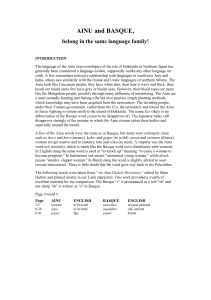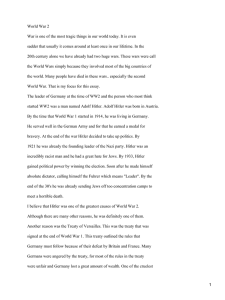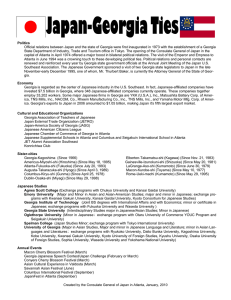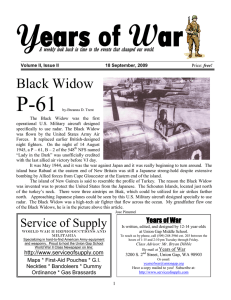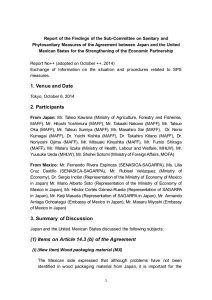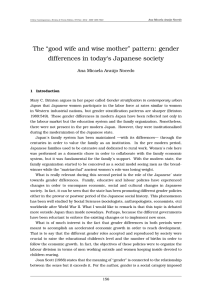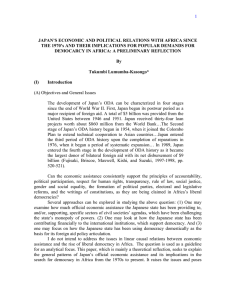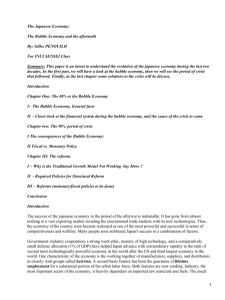THE AINU ASSIMILATION POLICIES DURING THE MEIJI PERIOD
Anuncio
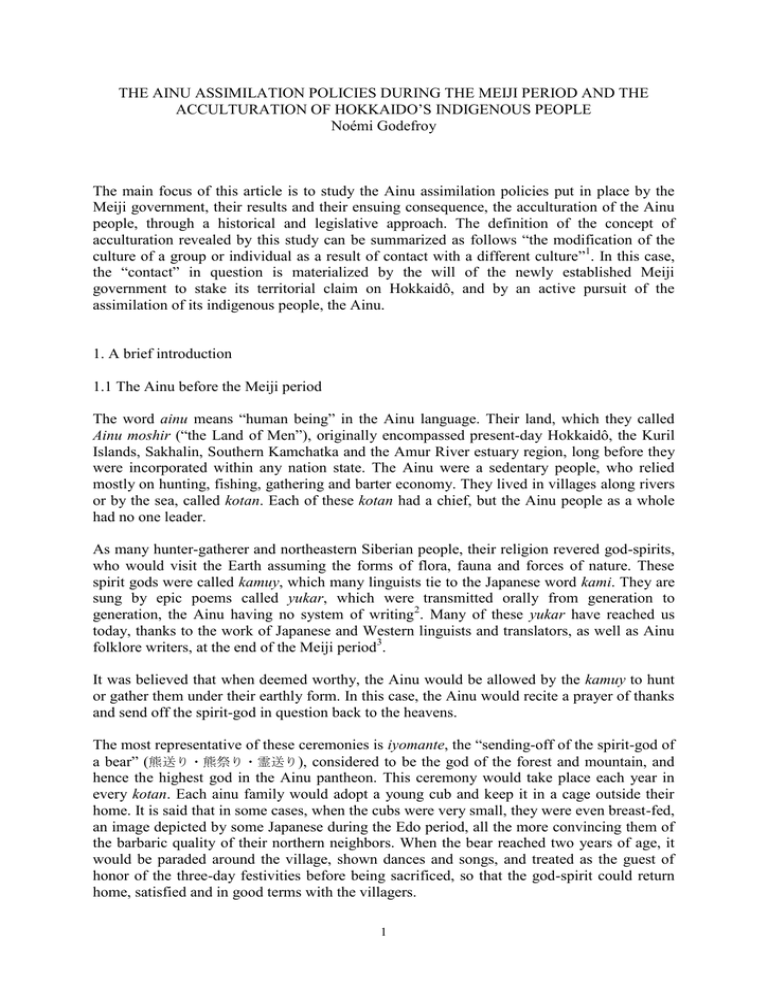
THE AINU ASSIMILATION POLICIES DURING THE MEIJI PERIOD AND THE ACCULTURATION OF HOKKAIDO’S INDIGENOUS PEOPLE Noémi Godefroy The main focus of this article is to study the Ainu assimilation policies put in place by the Meiji government, their results and their ensuing consequence, the acculturation of the Ainu people, through a historical and legislative approach. The definition of the concept of acculturation revealed by this study can be summarized as follows “the modification of the culture of a group or individual as a result of contact with a different culture”1. In this case, the “contact” in question is materialized by the will of the newly established Meiji government to stake its territorial claim on Hokkaidô, and by an active pursuit of the assimilation of its indigenous people, the Ainu. 1. A brief introduction 1.1 The Ainu before the Meiji period The word ainu means “human being” in the Ainu language. Their land, which they called Ainu moshir (“the Land of Men”), originally encompassed present-day Hokkaidô, the Kuril Islands, Sakhalin, Southern Kamchatka and the Amur River estuary region, long before they were incorporated within any nation state. The Ainu were a sedentary people, who relied mostly on hunting, fishing, gathering and barter economy. They lived in villages along rivers or by the sea, called kotan. Each of these kotan had a chief, but the Ainu people as a whole had no one leader. As many hunter-gatherer and northeastern Siberian people, their religion revered god-spirits, who would visit the Earth assuming the forms of flora, fauna and forces of nature. These spirit gods were called kamuy, which many linguists tie to the Japanese word kami. They are sung by epic poems called yukar, which were transmitted orally from generation to generation, the Ainu having no system of writing2. Many of these yukar have reached us today, thanks to the work of Japanese and Western linguists and translators, as well as Ainu folklore writers, at the end of the Meiji period3. It was believed that when deemed worthy, the Ainu would be allowed by the kamuy to hunt or gather them under their earthly form. In this case, the Ainu would recite a prayer of thanks and send off the spirit-god in question back to the heavens. The most representative of these ceremonies is iyomante, the “sending-off of the spirit-god of a bear” (熊送り・熊祭り・霊送り), considered to be the god of the forest and mountain, and hence the highest god in the Ainu pantheon. This ceremony would take place each year in every kotan. Each ainu family would adopt a young cub and keep it in a cage outside their home. It is said that in some cases, when the cubs were very small, they were even breast-fed, an image depicted by some Japanese during the Edo period, all the more convincing them of the barbaric quality of their northern neighbors. When the bear reached two years of age, it would be paraded around the village, shown dances and songs, and treated as the guest of honor of the three-day festivities before being sacrificed, so that the god-spirit could return home, satisfied and in good terms with the villagers. 1 In this regard, they had the highest respect for all of nature’s creatures and wasted very little. This delicate balance was more and more at a peril with the growing dependency of the Ainu people towards Japanese commercial goods, and the growing intrusion of the Ainu territory by merchants and hunters during the second half of the Edo period. 1.2 The Matsumae domain’s legacy: emphasizing Ainu foreignness Contact between the Ainu and the Japanese dates back to at least the 14th century. As commercial ties grew stronger, Japanese settlers, hunters and merchants gradually encroached on Ainu territory and encounters became increasingly belligerent. Japanese settlement and subjugation of the Ainu increased after the establishment of the Matsumae domain on the southernmost tip of Hokkaidô in 1590. During most of the Edo period, the relationship between the Japanese and the Ainu was materialized by the commercial, economical and at times military domination of the island of Ezo and its indigenous inhabitants, exercised by the Matsumae domain 4 . Thus, in order maintain the Ainu under strict supervision and in a state of commercial dependency on Japanese goods, the Ainu were kept in a state of ignorance, forbidden to learn the Japanese language and practice agriculture. Furthermore, in order to justify its role as keeper of the peace and intermediary between the Tokugawa shogunate and the Ainu, the Matsumae domain emphasized their foreignness and barbaric appearance, regularly staging such diplomatic practices as “barbarians audiences”, called uimam, during which ainu leaders in full traditional attire would be paraded in the streets before paying tribute to the lord of the Matsumae clan5. 1.3 The Tokugawa shogunate’s legacy: the first Ainu assimilation measures As foreign territorial pressure -especially Russian- rendered the area more and more unstable starting at the end of the 18th century, many amongst the intellectual elite surrounding the shogun started to promote a firmer control of the area, some going as far as to suggest proper colonization6. Following Ainu rebellions in the Kuril Islands, in 1799, the shogunate decided to take matters into its own hands and take direct control of Ezo, overruling the Matsumae domain’s centennial authority on the region. This spurred a radical change in Japanese policies towards the Ainu, thus marking the beginning of the assimilation measures. The relationship between Japan and the Ainu during the Edo period and at the turn of Meiji can be theorized by David Day’s concept of “supplanting societies”, or that of “internal colonialism”, according to which a national center exploits and subjugates people at its periphery, while making its claim superior to the pre-existing people (Day (2008 : 6)) , in this case the Ainu, as well as being superior to any other society that might challenge it, in this case, the Russians especially7. 2. The Meiji turning-point : annexation and assimilation The island of Ezo, renamed Hokkaidô in 1869, is considered as terra nullius (「無主の地」) by the Hokkaidô Land Regulation (Hokkaidô tochi urikashi kisoku chijokisoku「北海道土地 売貸規則・地所規則」) of 1872 and redistributed amongst Japanese settlers. The annexation 2 was crucial to the newly established Meiji government in the sense that it asserted Japan’s position in the region, while serving as a buffer zone, -especially against Russia. Moreover, Hokkaidô offered numerous possibilities to exploit natural resources as well as offer employment and prospects to the ex-bushi class, who had to find a new place and a new trade in Japanese society. In these regards, it was important to assimilate the Ainu as quick as possible, leading to the establishment of the Ainu assimilation policies (アイヌ同化政策). 2.1 Legal assimilation The first aim of these assimilation policies was to create a new legal identity for the Ainu as Japanese imperial subjects (kôminka 皇民化). In 1871, they are officially integrated into the heimin (平民 common people) by the Family Registration Law (kôsekihô 戸籍法). In spite of this, they are not considered equal to the Japanese, and their official legal denomination from 1878 is kyûdojin (旧土人), which literally means “former aborigine”. This denomination constitutes a constant reminder of their past as rightful occupants of Hokkaidô, - a status that is now denied to them-, while preventing them from envisioning a future as Japanese imperial subjects and a place in Japanese society. They are defined by what they were, but are no longer allowed to be, and not by what they must become. As the final touch to the legal assimilation measures, Ainu military conscription (Ainu chôheirei, アイヌ徴兵令) is carried out throughout Hokkaidô in 18988. 2.2 Administrative assimilation As part of Japan’s first modern population census in 1872 (jinshinkoseki「壬申戸籍」), an Ainu population census also takes place. At this time, the administrators sent to Hokkaidô to carry it out were also in charge of “japanizing” Ainu surnames. In order to do so, they often randomly attributed new surnames and according to contemporary sources, on many an occasion, a part or even a whole village was given the same name, regardless of family ties9. These family ties were of course of great importance to the Ainu. Up until that point, their lineage had been symbolized by the passing down of a sacred family symbol, called ekashi shiroshi (“old man symbols”). They were revealed only within the family circle and adorned arrows to determine which family had made the catch during hunting parties, and men’s ceremonial headdress. Similarly, the Ainu women wore “bosom girdles” (upsor kut) under their clothing, whose design was passed on by the mother, and that must be kept secret from Ainu men, as a way to prevent misfortune on the family and as a symbol of the matrilineal lineage. Both these girdles and the ekashi shiroshi were believed to be used as safe-conducts by the deceased to be rejoined with his ancestors in the Land of the Dead. These symbols were rendered useless by the random attribution of surnames to the Ainu, and very few have made it back to us. 3 In parallel, the Hokkaidô Development Agency (kaitakushi 開拓使), -the institution officially charged with governing and developing Hokkaidô from 1869 to 1882 -, changed most of Hokkaidô’s toponyms from the Ainu language to Japanese, further dispossessing the Ainu of their land, and of their status as rightful occupants. 2.3 Cultural assimilation Turning the Ainu into imperial subjects also required banning certain traditions that highlighted their identity as a separate and different ethnic group. In 1871, the practice of chise gomori, the ritual burning of a deceased person’s house (chise in the ainu language), is outlawed. The Ainu believed that after death, the deceased person became a ghost that could haunt its home during its transhumance between the human world and the spirit world, bringing misfortune to the village. Hence, the house had to be burned, then rebuilt. In this case, the banning of such a practice gave birth to a new one, showing the Ainu were also capable of adaptation in certain cases, according to which the deceased person would be removed from the house by a hole in the wall, so as not to find the door, and carried to the graveyard after meandering around the village, so as not to remember the way from the grave to the house10. Furthermore, all of the deceased person’s possessions were broken and the house rearranged, so the ghost would not be able to recognize its own house. In 1876, the Hokkaidô Development Agency tackles another Ainu tradition, that of male earrings and especially of women’s ritual tattoos. They served as the most visible reminder of a separate culture, one that must be done away with if assimilation is to take place. The Ainu women were tattooed around their mouth and on their arms. The tattoo around their mouth is initiated at age three and completed by the time they get married. This tradition is believed to have been brought to Earth by the ancestral Mother, and younger sister of the Creator God. For the Ainu, the tattoo completed at betrothal, was a symbol that any word coming out of a woman’s mouth would now belong to her husband, while preventing evil spirits to speak, or to enter through a woman’s mouth. Similarly, the Ainu motifs (moreu) on their clothing were also believed to keep the evil spirits and misfortune out of their body. Where the Japanese were concerned, according to their own cultural system, tattooing was associated with crime and punishment whereas the practice itself was regarded as a form of body mutilation, which, in case of voluntary infliction, was completely averse to the prevalent notions of Confucian filial conduct. It is attested by foreign visitors’ travel logs, such as that of Isabella Bird, that the Ainu were very distraught after these bans were put in place, worrying about the anger of their gods, and the incapacity for Ainu women to find a husband11. As a result of this legal, bureaucratic and cultural assimilation, the Ainu were stripped of their identity as a people, as families and as individuals. The next step that is taken by the Hokkaidô Development Agency will aim at making them an active part of the exploitation of the new Japanese frontier territory. 2.4 Agricultural redeployment 2.4.1 Laws and regulations: Allotment and redistribution 4 For the Hokkaidô Development Agency, it was crucial to develop a productive agriculture as fast as possible on the island. Hence, it had to lure settlers from the rest of Japan to Hokkaidô. In order to do so, it enacted several land distribution laws. Many of these laws were inspired by American allotment and land redistribution laws regarding the Indian territories that were being instated at this time12. Here one can feel the influence of the American Foreign advisors (oyatoi gaikokujin お雇い外国人 ) on the Hokkaidô Development Agency, such as Horace Capron. As we have seen previously, the Hokkaidô Land Regulation declares all the land without a legal ownership unoccupied (terra nullius) in 1872. This is of course the case of all of Hokkaidô. This is confirmed by the 1873 the Revised Land tax regulation (Chisokaisei 「地租 13 改正条例」). Later laws offer land at an attractive price for prospective Japanese buyers . 2.4.2 Turning the Ainu into farmers: Outlawing traditional Ainu modes of subsistence As for the Ainu, they represented a cheap and unemployed labor force, which presented the advantage of already living on the island. Hence, in order to turn this hunter-gatherer people into farmers, the Development Agency had to do away with their previous modes of subsistence, which mainly consisted in hunting deer and fishing salmon and trout. In 1876, the traditional Ainu bow and poison arrows were outlawed. At the same time, the drastic decline of animal populations due to overhunting by the Japanese, armed with rifles, led the Agency to enact other laws, to try and regulate these populations. Such a law was the 1875 Iburi-Hidaka regions Dear Hunting Regulation(胆振日高両州方面鹿狩規則 Iburi Hidaka ryôshûhoumen shikakari kisoku), which restricted the hunting periods the number of rifles in circulation and the number of authorized hunters. In the same way, Ainu traditional fishnets were also outlawed, and in 1878, fishing salmon or trout followed the same fate. 3. The Hokkaidô Former Aborigine Protection Act 3.1 Its origins 3.1.1 Ainu pauperization The consequences of these measures are devastating, the Ainu are weakened and no longer have any mode of subsistence, albeit they become farmers. The situation is such that in 1882, when the Hokkaidô Development Agency is replaced by three prefectural governments, Sapporo-ken, Nemuro-ken and Hakodate-ken, the first Ainu protection acts are passed14. In 1886, the Hokkaidô Government (Hokkaidô chô 北海道庁) is instated, putting an end to such protection measures. 3.1.2 Increasing Japanese settlement and land conflicts The twenty odd years separating 1892 and 1921 witness Hokkaidô’s immigration peak. It also marks a period rampant with corruption among some of the Hokkaidô Government’s administrators and the beginning of territorial conflicts with the Ainu. An example of such a conflict is the Chikabumi ainu land conflict (Chikabumi Ainu Kyûyochi jiken 近文アイヌ給与 地事件). Faced with the massive arrival of Japanese settlers, the Hokkaidô Government had 5 put aside land for the Ainu in the Chikabumi region (Dojin kyûyoteichi 土人給与定地) in 1891, but that land had been handed out against financial bribes. As Ainu voices rose to protest and started reaching the media, the land was restored in 1899. This is the first publicized conflict of the sort, but it would be followed by many others, the last one in date being the Nibutani Dam from 1990 to 1997. This conflict, as well as the Ainu people’s pauperization, led to the establishment of the Hokkaidô Former Aborigine Protection Act (Hokkaidô kyûdojin hogohô, 北海道旧土人保護法) in 1899. 3.2 Its content This Act will provide answer to both the need for assimilation and pauperization issues the Ainu face. It states that Ainu people who make a written demand for land and bring waste land under cultivation have restricted ownership rights on the said land and it guarantees seeds and farming tools to those who can’t afford them. These articles are very similar to the ones in the Dawes Act of 1887, regarding the Native Americans, and were most probably also inspired by American Foreign advisors. Moreover, the Protection Act provides a very limited medical care to the elderly and children, as well as school supplies. What is most striking about this law is that compared to the land distribution laws for Japanese settlers, the surface of the lots is five to ten times smaller15. Moreover, the concept of ownership in these two sets of laws is dramatically different. The Ainu cannot sell or lease their land, which can be confiscated at any given time by the authorities in case of mishandling. Furthermore, a large majority of the Ainu people still cannot read or write at this time, making it all the more difficult to apply, and making them all the more vulnerable to possible swindling. Finally, seeds and farming tools are supplied, but the act doesn’t stipulate how untrained Ainu can learn farming techniques. In many cases, this was made even worse by the quality of the land the Ainu were given, often hilly and improper for agriculture. On top of all that, the law concerned only the Ainu who wished to engage in agriculture, and not those working around coastal settlements. Furthermore, it did not fit the familiar patterns of Ainu labour division, according to which women would farm small plots of land, while the men engaged in hunting, fishing or day labour16. As expected, the practical results of this act were disappointing. In 1909, most of the 9 656 hectares given to the Ainu had been abandoned or rented to Japanese tenant farmers17. In 1916, only half of the Ainu population practices agriculture, and a vast majority of these farmers survive without actually profiting off of their land18. About ¾ of the Hokkaidô Ainu received some land under the Protection Act in 1899, but of these only about ne half were successful at farming19. Also, if the Protection law did shield the Ainu from the predations of majority Japanese who might try to deprive them of their landed property, but included no provisions for helping Ainu establish themselves in non-agricultural occupations. 3.2 Assimilation through an adapted education An adapted education for Ainu children made it possible to achieve two purposes at the same time : turning the Ainu into farmers and imperial subjects. 6 In 1872, the Temporary Development School (Kaitaku Karigakkô 開拓使仮学校) was opened in the Zôjôji Temple in Tôkyô and welcomed thirty-five Ainu students. They were taught reading, writing, agriculture and livestock farming. This first experience was a failure, as the Ainu students, far away from their home and families, were sent back to Hokkaidô in the end. In 1873, the Ryôtoku School of Otaru welcomes a few Ainu students amongst its Japanese students, but this experience is the only one of its kind, and Ainu children will not be accepted to Japanese schools until 1937. Instead, they will be sent to special schools, called “aborigine schools” (kyûdojin gakkô 旧土人学校). The first one opens in 1877 in Tsuikari. From 1879, such schools open in all of Hokkaidô. In 1891, the Hokkaidô Education Association (Hokkaidô Kyôiku Kyôkai, 北海道教育協会) is established to oversee the Ainu children’s education in these schools, and 10 years later, the Former Aborigine Elementary Education Regulation (Kyûdojin jidôkyûiku kitei 旧土人児童教 育規定) formalizes the separation between Japanese and Ainu students, the construction of the schools and the subjects that are taught. Ainu children are taught reading, writing, counting, health education, and agriculture. Speaking ainu is forbidden in these schools, as well as teaching history, geography and science. 3.3 Practical results Where practical results are concerned, school enrolment among Ainu children rose from under 45 percent in 1901 to 89 percent in 1907, and continued to rise thereafter, topping 99 in 1927. Of course, not every child attended regularly. Nevertheless, these schools play an important role in the assimilation process, and when the Crown Prince and future emperor Taishô visits Hokkaidô in 1911, he also visits one of these schools. 4. Consequences: Acculturation in lieu of assimilation, the contradictions and limits to the assimilation policies At the end of the Meiji period, what are the consequences of these assimilation measures? The Ainu can no longer live according to their traditional way of life. They went from being hunter-gatherers and traders to farmers or factory workers. They are no longer allowed to practice their religious customs, and the use of their native tongue is restricted. A cultural gap widens between generations, parents and children no longer speaking the same language or practicing the same customs. No longer considered Ainu, but still not considered Japanese, the former aborigines cannot find their place in Japanese society, and find themselves completely acculturated20. 4.1 The Ainu as “living exhibits” A significant anecdote is that of the 1904 World Expo in Saint Louis. The Ainu have been integrated to the Japanese officially for more than thirty years, and yet nine Ainu are sent to represent Hokkaidô natives as “living exhibits”. The participation of the Ainu group in St. Louis was supported by Japanese officials as a way to separate and distinguish indigenous natives from the culturally (and racially) superior Japanese delegation sent to the fair. Indeed, 7 a famous front-piece of an official fair publication illustrated the racialized nature of such an imagined “evolutionary ladder” by depicting the Japanese as seven levels above the “hairy Ainu.” This event is symbolic of the discrimination the Ainu suffered at that time, but also shows concretely the limits set by the Japanese themselves into assimilating the Ainu in their midst. A similar event takes place during the 1910 British-Japan Exhibition in London. 4.2 The Ainu as “heroic former aborigines” On the other hand, Ainu participation in the Russo-Japanese War of 1904-1905 is used to promote patriotism and a significant number of “former aborigines” receive military decorations 21 . A few “brave former aborigines” (yûkan naru kyûdojin,「勇敢なる旧土人」 ) and their heroic acts are even praised by the media 22 . Nothing is said, however, of the discrimination they suffer within their respective battalions. 4.3 The Ainu language and the search for Japanese identity: between linguistic study and eradication Interestingly enough, it is also during the Meiji era that investigation and research focusing on peripheral languages, such as the Ainu language, by linguists such as Kindai.ichi Kyôsuke, was born from the desire to explain and clarify the cultural origins of the Japanese ethnos, a desire shared on the general level by Meiji statesmen and intellectuals. Hence, ironically, one can say that while actively encouraging the eradication of the Ainu language and identity, the Meiji government encouraged its study to delve deeper into the Japanese identity. 5. As a conclusion: Contemporary perspectives The acculturation of the Ainu was almost complete by the end of the Meiji period, but not their assimilation to the Japanese people. More than a century after Meiji, politicians such as Miki Takeo and Nakasone Yasuhiro denied respectively the existence of discrimination and that of a culturally distinct people in Japanese society23. One can feel that the Ainu were in fact assimilated theoretically, if not always effectively, as some discrimination persisted. At the end of the last century, and thanks to the efforts of Kayano Shigeru, the first Diet member of Ainu descent, the anachronistic Meiji assimilation laws were finally done away with. Almost a century after its establishment, the Hokkaidô Former Aborigene Protection Act is finally replaced in 1997 by the Act for the Promotion of Ainu Culture and Dissemination of Knowledge Regarding Ainu Traditions 24 . On June 6, 2008, a bi-partisan, non-binding resolution was approved by the Japanese Diet calling upon the government to recognize the Ainu people as indigenous to Japan and urge an end to discrimination against the group. The resolution recognized the Ainu people as "an indigenous people with a distinct language, religion and culture". One can only hope that this will lead to recognition, promotion and study of the Ainu culture in Japan. 8 Noémi Godefroy is a PhD candidate in Japanese history at the National Institute of Oriental Language and Culture Studies in Paris (research topic: the Ainu and the Sakoku) and a teaching assistant at the University of Strasbourg. [email protected] Main references BATTEN B. 2003. To the ends of Japan : pre-modern frontiers, boundaries, and interactions. Honolulu : University of Hawai’i Press. COTTERILL S. 2011. Ainu Success: the Political and Cultural Achievements of Japan's Indigenous Minority, The Asia-Pacific Journal Vol 9, Issue 12 No 2, March 21, 2011. DAY D. 2008. Conquest: How societies overwhelm each others. New York : Oxford University Press. 榎森進 2003『アイヌの歴史と文化』創童舎 EMORI S. 2003. Ainu history and Culture. Tôkyô : Sôdôsha. 北海道ウタリ協会アイヌ史編集委員会 1989『アイヌ史』 北海道出版企画センター Hokkaidô Utari Association Ainu History Group. 1989. Ainu History. Sapporo : Hokkaidô Shuppan Kikaku Sentâ. KAYANO S. 1994. Our Land was a Forest : An Ainu Memoir. Westview Press. 小笠原信之 『アイヌ差別問題読本「シサムになるために」』縁風出版 OGASAWARA N. 2000. The Ainu discrimination problem : in viexw of becoming good neighbours. Tôkyô : Ryokufu shuppan. 小熊英二 1998『〈日本人〉の境界―沖縄・アイヌ・台湾・朝鮮植民地支配から復 帰運動まで』 新曜社 OGUMA E. 1998. Fringes of « Japanese » - Okinawa, Ainu, Taiwan, Korea : from colonial domination to reinstatement movements. Tokyo : Shinyôsha. 更科源蔵 『アイヌと日本人』 NHK ブックス SARASHINA G. 1982. Ainu and Japanese. Tôkyô : NHK Books. SIDDLE R. 1996. Race, Resistance and the Ainu of Japan. London : Routeledge. 新谷行 1978『アイヌ民族と天皇制国家』 三一書房 SHINYA G. 1978. The Ainu people and the Japanese imperial state. Tôkyô : San.ichi shobô. 高倉新一郎 1972『新版アイヌ政策史』 三一書房 Takakura Shin.ichirô. 1972. Revised History of Ainu regulations. Tôkyô: San.ichi shobô. 9 TAKAKURA S., HARRISON J. 1960. The Ainu of Northern Japan: A story of conquest and Acculturation. American Philosophical Society. WALKER Brett L., 2006. The Conquest of Ainu Lands: Ecology and Culture in Japanese Expansion, 1590-1800. Berkeley. University of California Press. 1 Possible Japanese translations are: 文化の接触変化・文化触変・文化変容・アカルチュレーション . For more on the yukar in English, see Philippi D. 1979. Songs of Gods, songs of humans : the epic tradiction of the Ainu. Princeton University Press and the yukar translation project Project U-e-peker website. 3 Among these, the most famous are probably the English missionary John Batchelor, the Japanese linguist Kinda.ichi Kyôsuke and the Ainu writers Kannari Matsu and Chiri Yukie. 4 For more on Japanese-Ainu relations during this period in English, see Walker B. 2006 The Conquest of Ainu Lands : Ecology and Culture in Japanese Expansion 1590-1800. Berkeley : University of Caifornia Press. 5 For more on these « barbarians audiences », see Howell D. 1994 « Ainu Ethnicity and the boundaries of the Early Modern Japanese State », Past and Present 142 (February 1994) , MORRIS-SUZUKI T. 1994 “Creating the Frontier: Border, Identity, and History in Japan’s Far North”, East Asian History 7, 1994, pp.1-24 and Inagaki Reiko, « 近世蝦夷地における儀礼支配の特質 ウイマム・オムシャの変遷を当して », 『民衆生活と信 仰・思想』民衆史研究会, 1985, pp.111-3 6 Among these intellectuals, one can find Hayashi Shihei, Kudô Heisuke and Honda Toshiaki. 7 For more on this issue in English, see LENSEN G. 1959 The Russian Push towards Japan, Russo-Japanese relations, 1697-1875. Princeton : Princeton University Press. 8 The Meiji Military conscription Law in Japan dates back to 1873, 1898 for Hokkaidô, the Bonin Islands and the Ryû-Kyû. In 1877, military conscription is carried out in Hakodate, Fukuyama (present day Matsumae chô) and Esatsu. In 1896, it spreads to Oshima, Kunashir, Iburi, Ishikari, in 1898 to Hokkaidô as a whole. The first official Ainu army recruit was in 1896. Until 1910, 136 Ainu were recruited in the active service and 382 served as reservists. 9 On this issue, see Kayano S. 1994. Our Land was a Forest : An Ainu Memoir. Westview Press. 10 On this see Leroi-Gourhan, A. and A. 1989. Un Voyage chez les Aïnous : Hokkaidô 1938. Paris : Albin Michel. 11 On this, see Bird I. 2000. Unbeaten Tracks in Japan. A traveler’s Tale. 12 The Desert Land Act was passed by the United States Congress on March 3, 1877 to encourage and promote the economic development of the arid and semiarid public lands of the Western states. Through the Act, individuals may apply for a desert-land entry to reclaim, irrigate, and cultivate arid and semiarid public lands. The act offered 640 acres (2.6 km2) of land to an adult married couple who would pay $1.25 an acre and promise to irrigate the land within three years. A single man would only receive half of the land for the same price. Individuals taking advantage of the act were required to submit proof of their efforts to irrigate the land within three years, but as water was relatively scarce, a great number of fraudulent "proofs" of irrigation were provided. 13 The laws in question are the following : the 1877 Hokkaidô Land Deed Issuance Regulation (Hokkaidô Chiken hakkô Jôrei 北海道地券発行条例), the 1886 Hokkaidô Regulation for Transferring Government Land to Private Ownership (Hokkaidô Tochi Haraikudari Kisoku 「北海道土地払下規則」) and the 1897 Undeveloped Hokkaido National Lands Disposal Act (Hokkaidô Kokuyû Mikaichi Shobunhô「北海道国有未開地処分法」). 14 These measures are : the 1883 Former Aborigene Education Allocation (Kyûdojin Kyôikukin 旧土人教育金) and Hokkaidô Former Aborigine Education Fund (Zendô kyûdojin kyôiku shikin 全道旧土人教育資金) and the 1884 Nemuro Prefecture Former Aborigine Relief Law (Nemuro-ken kyûdojin kyûzai hôhô 根室県内旧土人救済 方法) and Sapporo Prefecture Former Aborigine Relief Law (Sapporo-ken kyûdojin kyûzai hôhô 札幌県内旧土人 2 救済方法 ). 15 Because agricultural promotion lay at the heart of the state’s colonization efforts in Hokkaidô more generally, giving the Ainu adequate amounts of fertile land would have imperilled the ability of immigrants from the mainland to contribute to the island’s development. 16 Peng Fred C.C., Robert Ricketts, Nario Imamura, “The Socioeconomic status of the Ainu: the Past in the Present”, American Ethnologist, Volume 1, number 4, November 1974, pp. 731-750, p.733 17 Peng Fred C.C., Robert Ricketts, Nario Imamura, “The Socioeconomic status of the Ainu: the Past in the Present”, American Ethnologist, Volume 1, number 4, November 1974, pp. 731-750, p.733 18 About one fifth of the land granted under the protection law was repossessed for non-cultivation. By 1923, only 45 percent of land grants were actually in Ainu hands, and only 19 percent of these were being cultivated by Ainu households. The land policy was upgraded in 1923 because it was not as successful as expected. Government experts were sent to instruct the Ainu farmers in methods of cultivation, and, in 1924, a Mutual Aid 10 Association (Gojo Kumiai) was set up to deal with rented land. If the Ainu farmer wished to rent out his land, it would first be turned over to the Chief of the association (the Japanese mayor of each respective district or county), who would then rent it himself. Rent would go to the Association, not the farmer. When the farmer decided he wanted to cultivate the land himself, it would be returned to him. This aimed at discouraging renting land out and aiding destitute Ainu farmers, unable to help themselves. As a consequence, utilized land increased to 60,7% and self-cultivated land to 36%. It was not until after 1947 that the Ainu actually became owners of their land. In 1987, only 1 360 hectares, 15 pour cent, of the land remained in Ainu hands. 19 Peng Fred C.C., Robert Ricketts, Nario Imamura, “The Socioeconomic status of the Ainu: the Past in the Present”, American Ethnologist, Volume 1, number 4, November 1974, pp. 731-750, p.740 20 This Ainu mal de vivre is sung by many young Ainu poets at the beginning of the 20th century, interestingly enough, mostly in Japanese. For some of these poems, see Iboshi Hokuto and his most famous anthology called Kotan. 21 63 Ainu soldiers were sent to war. 54 of them received a military decoration, 3 of them the Order of the Golden Kite, including Chiri Takakichi 知里高吉. 22 Kitakaze Isokichi 北風磯吉 participated on the Battle of Mukden (the “Sekigahara of the Russo-Japanese War”) from February 20th to March 10th of 1905, which totaled more than 250 000 casualties on each side, and during which he volunteered to be a liaison officer, facing certain death. 23 Here are some of these quotes :「本規約に規定する意味での少数民族はわが国に存在しない」 1980 年 日 本の外務省 (the Japanese Ministry of Foreign Affairs in 1980 : « There are no minorities in our country, in the accepted protocolar sense. »)「(日本には)単一民族という非常にいい、誇るべき長所がある」 1986 年 中曽根首相 (Prime Minister Nakasone in 1986 : « Japan is an extremely homogeneous nation, and that is an advantage we should be proud of .»)「日本国籍を持つ方々で差別を受けている少数民族はいない」 1986 年 中曽根首相 (Prime Minister Nakasone in 1986 : « There are no discriminated minorities amongst the people who have Japanese citizenship. ») 24 The law’s full denomination: アイヌ文化の振興並びにアイヌの伝統等に関する知識の普及及び啓発に関する 法律 (Ainu bunka no fukkô narabi ni Ainu no dentô nado ni kansuru chishiki no fukyû oyobi keihaysu ni kann suru hôritsu, the Law from the Development and Dissemination of Knowledge regarding Ainu traditions and for the Promotion of Ainu culture.) 11
